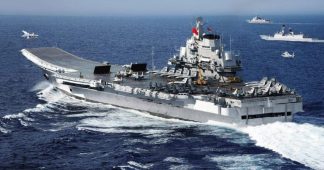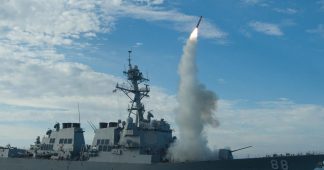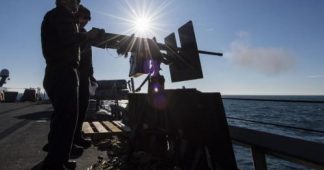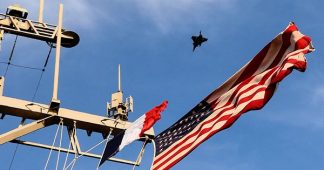How do you shoot down a hypersonic missile when you can’t even take down a normal one?
The new chief of naval operations, Adm. Michael Gilday, was confirmed quickly by the Senate last week [text is from two weeks ago], but lawmakers made clear that the cost and growing vulnerability of aircraft carriers to ever-faster and evasive missiles will be among the issues he’s expected to tackle when he officially takes the reins.
The Navy’s main force projection tool, the carrier, became a punching bag for several lawmakers at Gilday’s confirmation hearing, as they alternately raised the threat posed by Chinese and Russian hypersonic missiles and berated the Navy’s future top admiral for the significant delays and cost overruns associated with the new carrier Gerald R. Ford.
At one point during the July 31 hearing, the Senate Armed Services Committee Chairman Jim Inhofe, R-Okla., told Gilday the Navy’s arrogance on the carrier “ought to be criminal.” Later on, longtime friend of the Navy Sen. Angus King, I-Maine, warned that hypersonic missiles were a “nightmare weapon” that threatened to make carriers obsolete.
And while the lawmakers differed on the future of aircraft carriers and their long-term viability, the hearing left no doubt that Gilday, a career surface warfare officer, has his work cut out for him in proving he can guide the service toward a more stable future for the Navy’s most expensive and strategically invaluable assets.
To be clear, Inhofe does not oppose carriers, and he has publicly reminded multiple Trump administration officials of the Navy’s legal requirement to maintain 11 of them. Inhofe was in the bipartisan chorus of lawmakers who opposed Pentagon plans to cut costs by decommissioning the aircraft carrier Harry S. Truman before the administration scuttled those plans this year.
When it comes to the Ford program, Inhofe plans to keep the Navy on a short leash and pressed Gilday to commit that he would work to prevent the kind of widespread “first-in-class” issues that have plagued the Ford. It’s an issue with some urgency behind it, as the Navy prepares to tackle the new Columbia-class ballistic missile submarine for nuclear deterrent patrols, as well as a next-generation frigate, new classes of unmanned warships and a new large surface combatant.
“The Navy entered into this contract in 2008, which, combined with other contracts, have ballooned the cost of the ship more than $13 billion without understanding the technical risks, the costs or the schedules, and you know this ought to be criminal,” Inhofe said.
The Navy had taken a gamble integrating immature dual-band radar, catapult, arresting gear and weapons elevators, and Inhofe expressed displeasure with the result.
Tackling the first-in-class issue will be a priority, Gilday said.
“I commit to that and complete transparency as well as taking what we learn from the Ford and ensuring that we don’t commit those same mistakes again in the Columbia class and other ships that we need to field in the next few years,” Gilday told Inhofe.
‘Sitting ducks’
As for rising threats to the carrier, King believes hypersonic missiles are an existential threat to the Navy and urged Gilday to take the issue head on.
“Every aircraft carrier that we own can disappear in a coordinated attack,” King said. “And it is a matter of minutes. Murmansk, [Russia], to the Norwegian Sea is 12 minutes at 6,000 miles an hour.
“So I hope you will take back a sense of urgency to the Navy and to the research capacity and to the private sector that this has to be an urgent priority [To do what LOL? No amount of “research capacity” will give you the ability to intercept hypersonic missiles.] because otherwise we are creating a vulnerability that could in itself lead to instability.”
In an interview with Defense News, King said the speed at which the Russians and Chinese are fielding the capability worries him.
“My concern is that we are a number of years away from having that capacity, and our adversaries are within a year of deployment,” he said. “And that creates a dangerous gap, in my view. This represents a qualitative gap in offensive warfare that history tells we better figure out how to deal with, or it will mitigate our … advantage.”
King, who represents the state where half the Navy’s destroyers are produced, also said he’s concerned about the long-term viability of aircraft carriers in a world with hypersonic missiles.
“I think it does raise a question of the role of the aircraft carrier if we cannot figure a way to counter this capability,” he said. “I don’t want indefensible, $12 billion sitting ducks out there. I’m not prepared to say the carrier is obsolete, but I say that this weapon undermines the viability of the carrier.”
Inhofe, in response to another senator’s questions about carrier obsolescence, said he disagrees carriers are becoming obsolete, but that he’s concerned about the cost.
But the threats to the carrier are mounting, experts say. With the advent of ground-launched hypersonic missiles, it’s a matter of time before air-launched hypersonic missiles present a nearly insurmountable threat, barring a significant development to counter them.
“I think what King’s comments reflect is that he sees the vulnerability of the aircraft carrier only getting worse,” said Bryan Clark, a retired submarine officer and analyst with the Center for Strategic and Budgetary Assessments. “Specifically, maybe not so much these kind of boost-glide weapons, but its more about cruise missiles that are hypersonic — air-launched perhaps.
“Then you are talking about something that is relatively inexpensive and could be delivered in large numbers, and that would be a bigger deal because missile defenses are not necessarily built for hypersonic weapons.
“So we’ll have to find a way to deal with this new challenge, or we’ll have to rethink how we do things.”
Source: Defense News











